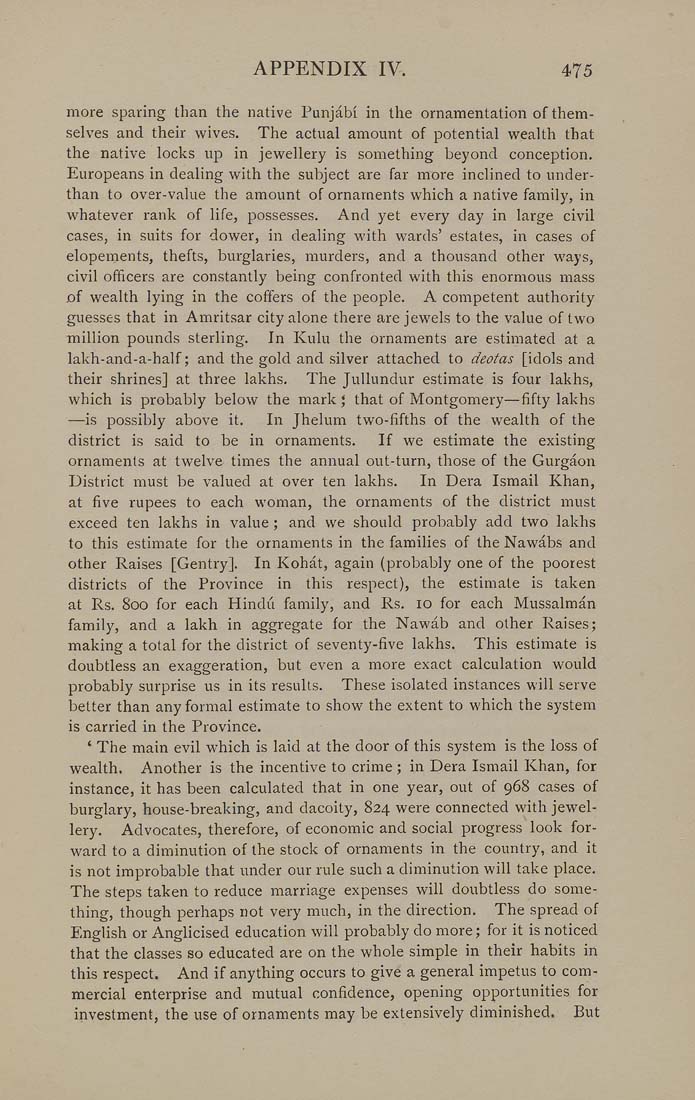APPENDIX IV. 475
more sparing than the native Punjabi in the ornamentation of them¬
selves and their wives. The actual amount of potential wealth that
the native locks up in jewellery is something beyond conception.
Europeans in dealing with the subject are far more inclined to under-
than to over-value the amount of ornaments which a native family, in
whatever rank of life, possesses. And yet every day in large civil
cases, in suits for dower, in dealing with wards' estates, in cases of
elopements, thefts, burglaries, murders, and a thousand other ways,
civil officers are constantly being confronted with this enormous mass
of wealth lying in the coffers of the people. A competent authority
guesses that in Amritsar city alone there are jewels to the value of two
million pounds sterling. In Kulu the ornaments are estimated at a
lakh-and-a-half; and the gold and silver attached to deotas [idols and
their shrines] at three lakhs. The JuUundur estimate is four lakhs,
which is probably below the mark; that of Montgomery—fifty lakhs
—is possibly above it. In Jhelum two-fifths of the wealth of the
district is said to be in ornaments. If we estimate the existing
ornaments at twelve times the annual out-turn, those of the Gurgaon
District must be valued at over ten lakhs. In Dera Ismail Khan,
at five rupees to each woman, the ornaments of the district must
exceed ten lakhs in value; and we should probably add two lakhs
to this estimate for the ornaments in the families of the Nawabs and
other Raises [Gentry]. In Kohat, again (probably one of the poorest
districts of the Province in this respect), the estimate is taken
at Rs. 800 for each Hindu family, and Rs. 10 for each Mussalman
family, and a lakh in aggregate for the Nawab and other Raises;
making a total for the district of seventy-five lakhs. This estimate is
doubtless an exaggeration, but even a more exact calculation would
probably surprise us in its results. These isolated instances will serve
better than any formal estimate to show the extent to which the system
is carried in the Province.
' The main evil which is laid at the door of this system is the loss of
wealth. Another is the incentive to crime; in Dera Ismail Khan, for
instance, it has been calculated that in one year, out of 968 cases of
burglary, house-breaking, and dacoity, 824 were connected with jewel¬
lery. Advocates, therefore, of economic and social progress look for¬
ward to a diminution of the stock of ornaments in the country, and it
is not improbable that under our rule such a diminution wdl take place.
The steps taken to reduce marriage expenses will doubtless do some¬
thing, though perhaps not very much, in the direction. The spread of
English or Anglicised education will probably do more; for it is noticed
that the classes so educated are on the whole simple in their habits in
this respect. And if anything occurs to give a general impetus to com¬
mercial enterprise and mutual confidence, opening opportunities for
investment, the use of ornaments may be extensively diminished. But
|








